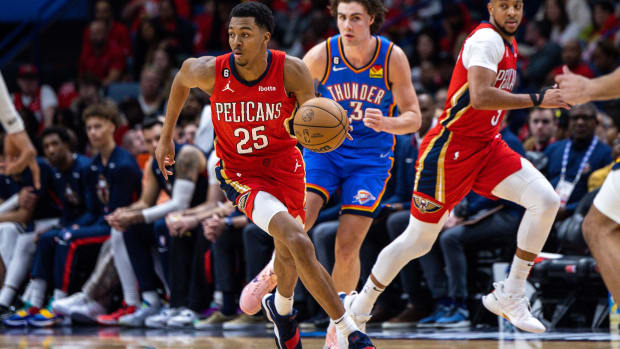For the last several years, dating back to the Anthony Davis era, injuries have been the bane of the Pelicans’ existence.
DeMarcus Cousins tore his Achilles during what would have been his first full season in New Orleans alongside Davis. Zion Williamson has shown to be dominant, but the caveat is that he hasn’t been able to consistently stay on the court. And even during the time Williamson was on the court healthy last season, fellow star Brandon Ingram often wasn’t, keeping the Pelicans from achieving their full potential.
Which gets to why the news from earlier this week—that New Orleans wing Trey Murphy III injured his left meniscus during an offseason workout and may require surgery—has to be so frustrating for the organization. In many ways, it feels like a make-or-break campaign for this iteration of the club, which won 42 games last season, even as it’s still waiting to see what this deep group looks like when all its best players are available.

Stephen Lew/USA TODAY Sports
After last season, it’s clear that Murphy has joined that group. With 85 dunks in 2022–23, he has proved to be wildly athletic—he took part in last season’s dunk contest—but he’s also a constant threat from the perimeter, having shot 40.6% from deep on more than six attempts per game. Those numbers would be outstanding for almost anyone. But with a team like the Pelicans, who already have first, second and third stars in Williamson, Ingram and CJ McCollum, Murphy’s skill set is invaluable, as it represents exactly the sort of guy nearly every championship-caliber club needs.
Murphy, 23, was undoubtedly one of the league’s most-improved players last season, going from 62 appearances as a rookie to 65 starts in his second campaign and shooting a whopping 61% from two-point range in Year 2 after connecting on just 41.8% of his two-point tries in that first season as a pro. His 9.1-point improvement in scoring average was the second-biggest leap in the league last season, trailing only Lauri Markkanen, who won the NBA’s Most Improved Player award.
How long the injury will keep Murphy out remains undetermined, largely because there are two potential surgical routes that could be taken, if surgery is ultimately needed. A full meniscus repair would require a much longer recovery but is generally seen as the preferred route, as it prevents long-term deterioration and lends itself to better longevity for players. A removal would allow for a quicker return to play—usually a matter of weeks, as opposed to months—but is generally associated with having a shorter career window as a result.
With Herbert Jones, Dyson Daniels and Naji Marshall, the Pelicans have solid depth on the wing to fill Murphy’s spot while he’s out. But it’s also fair to say that however long Murphy remains sidelined is less than ideal for a team that’s already battled key injury after key injury for the last several years—particularly as New Orleans heads into a critical campaign where it will try to get everyone on the same page, once and for all.







